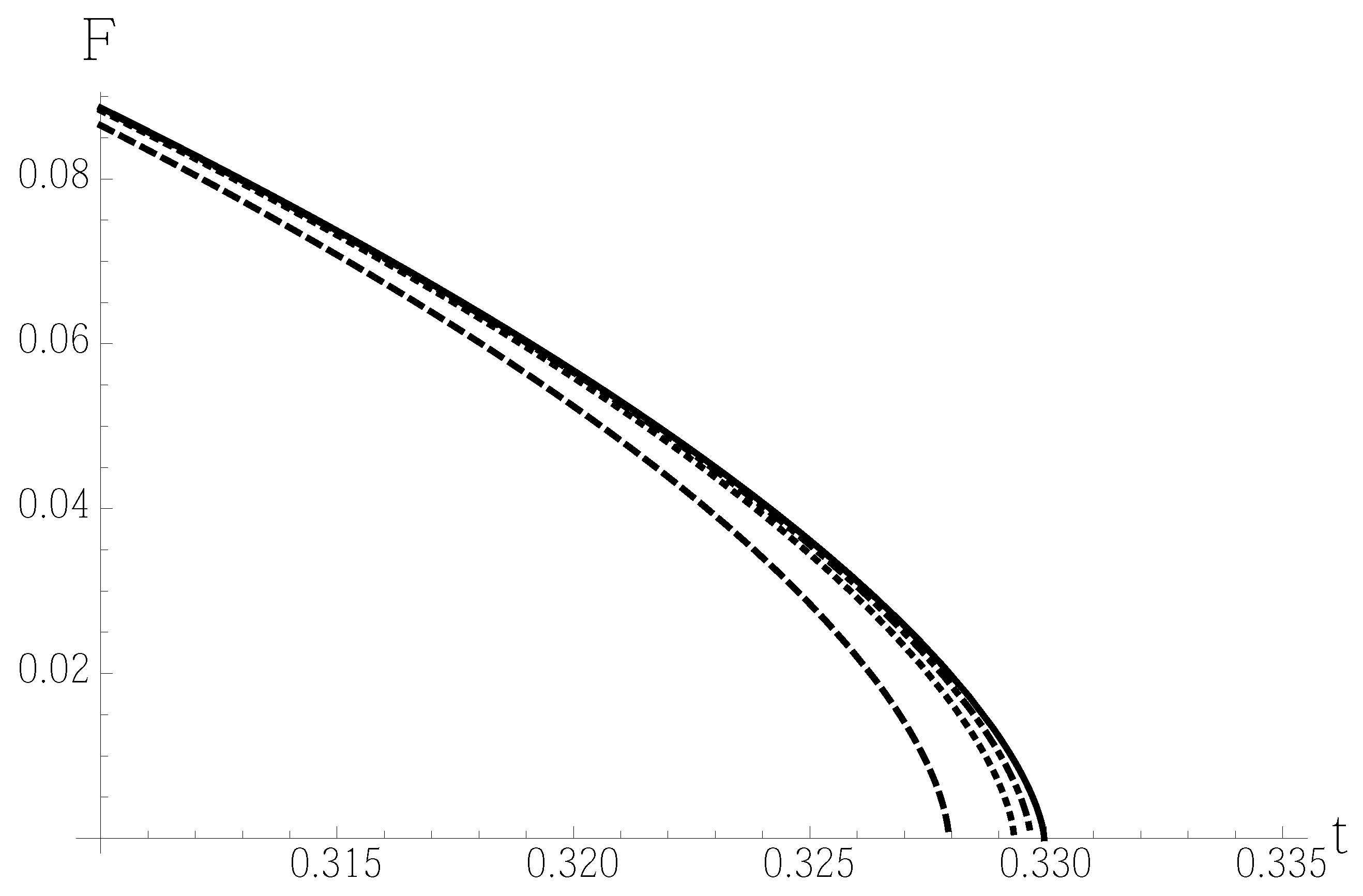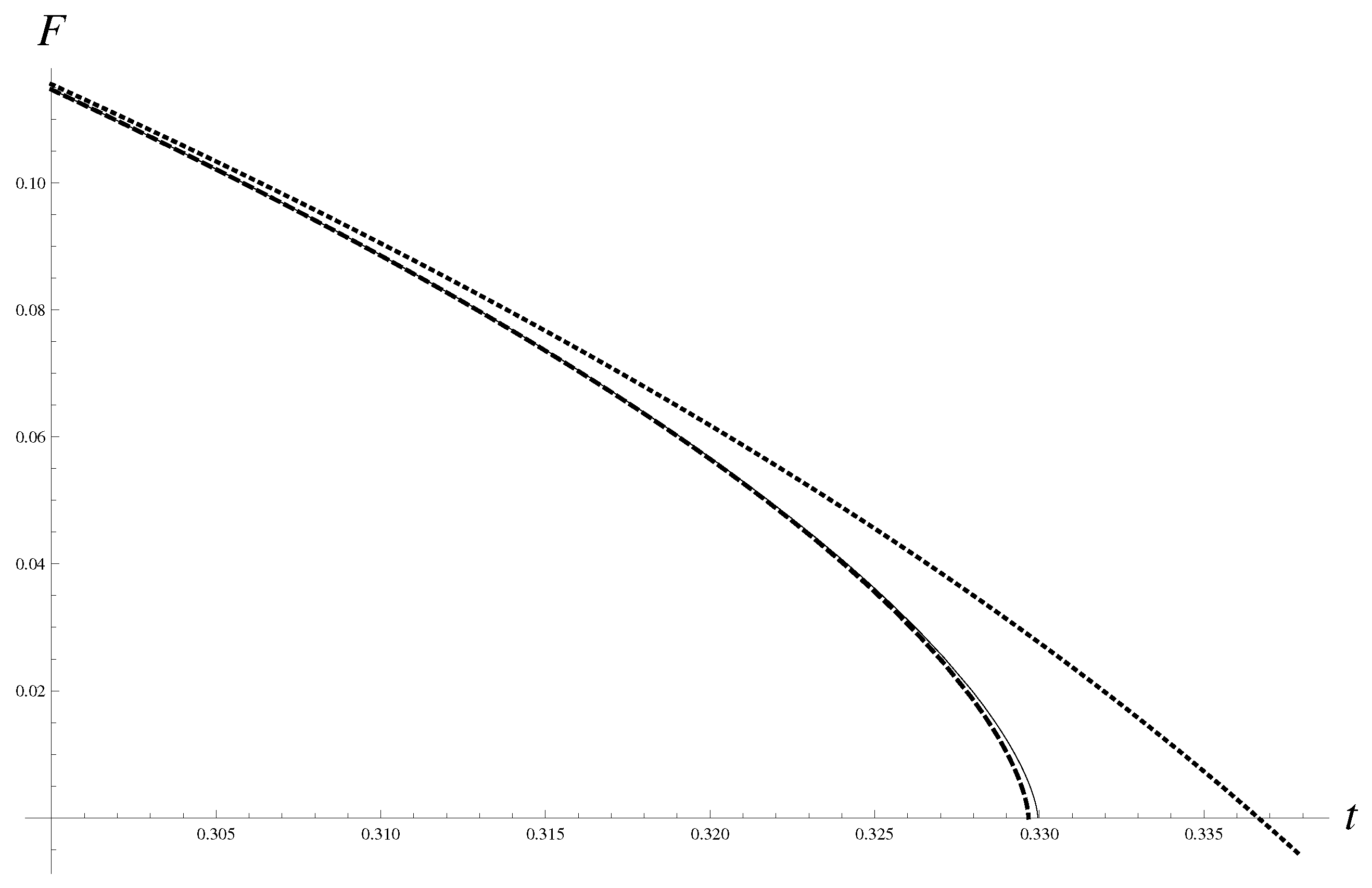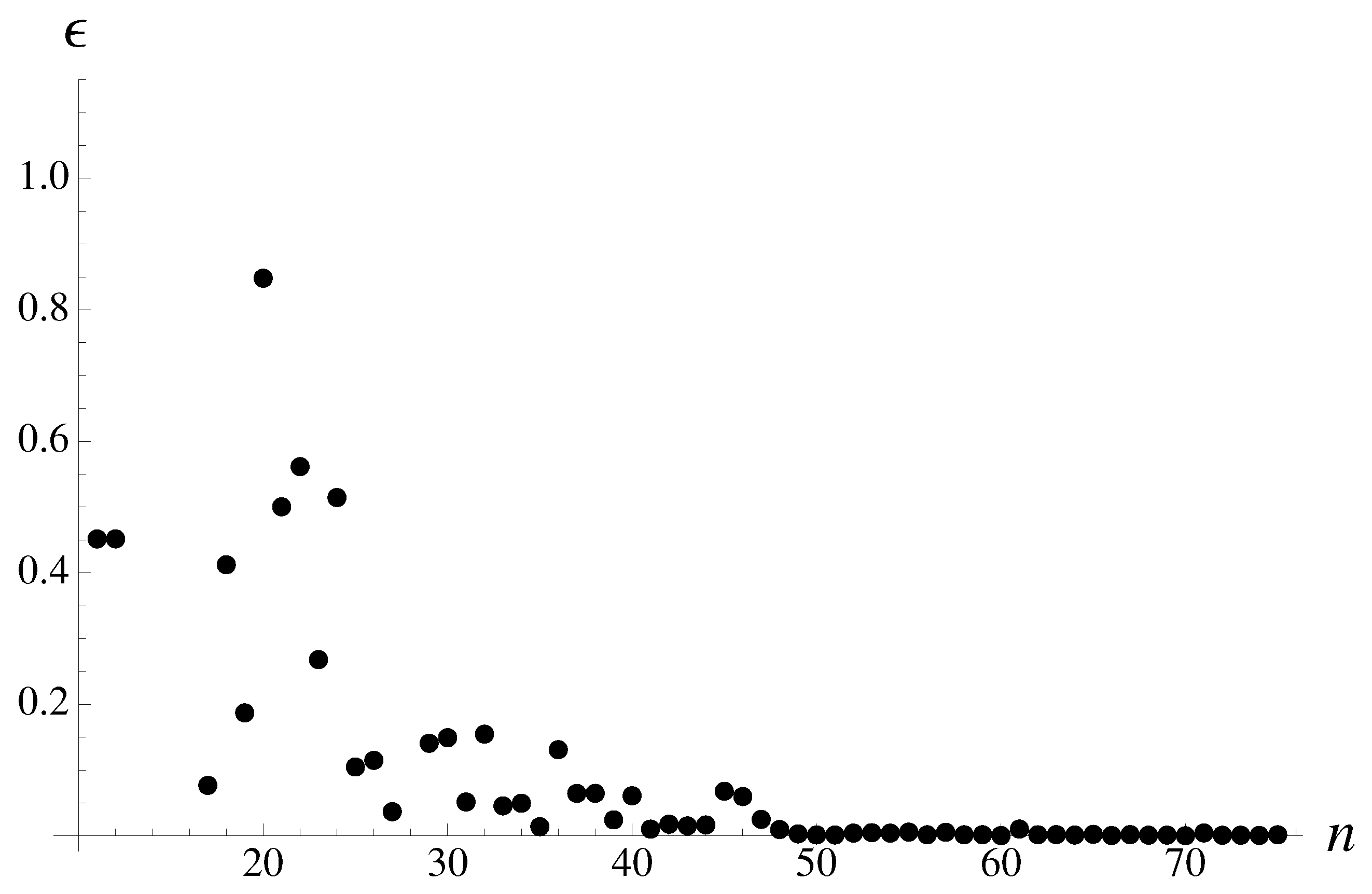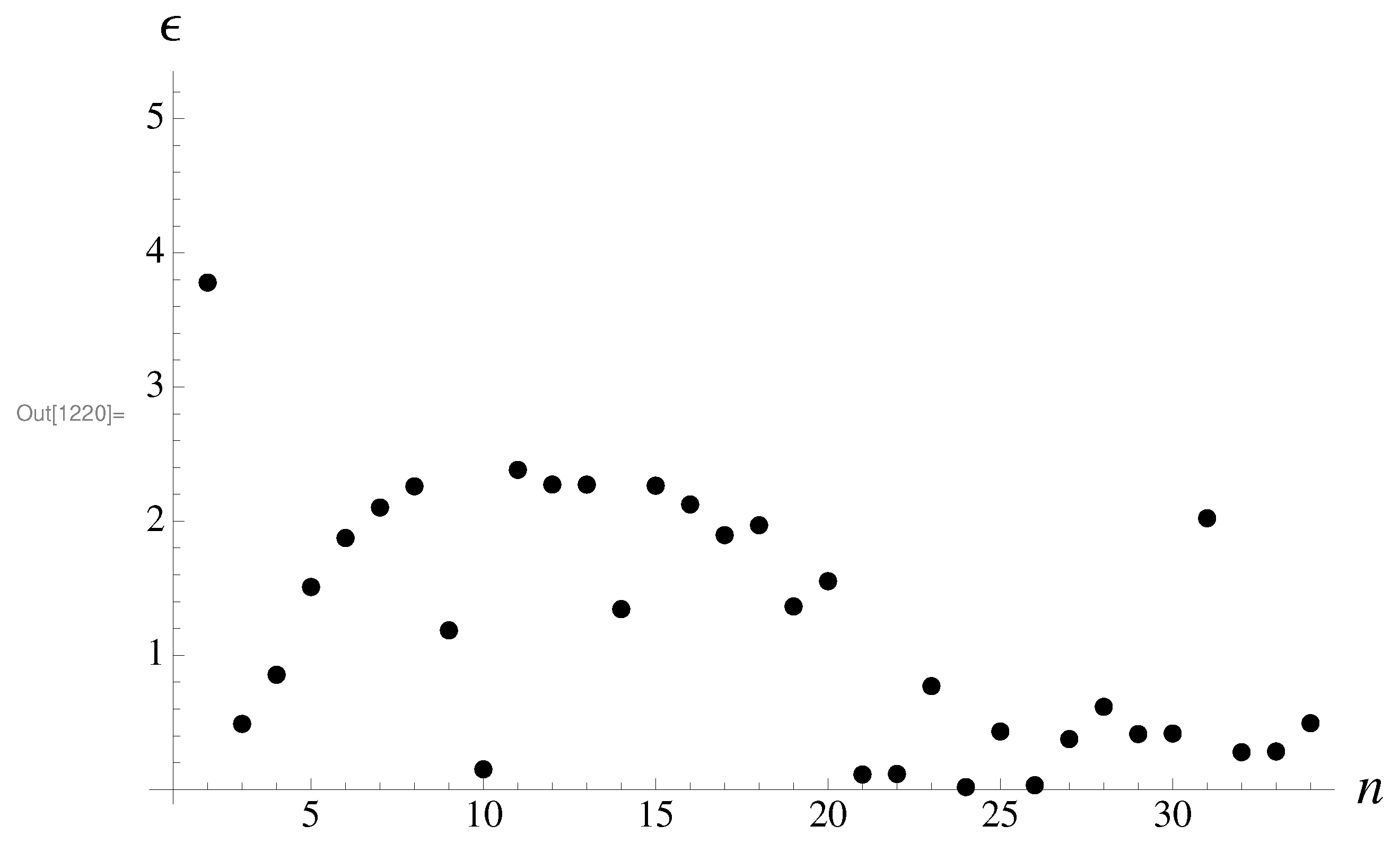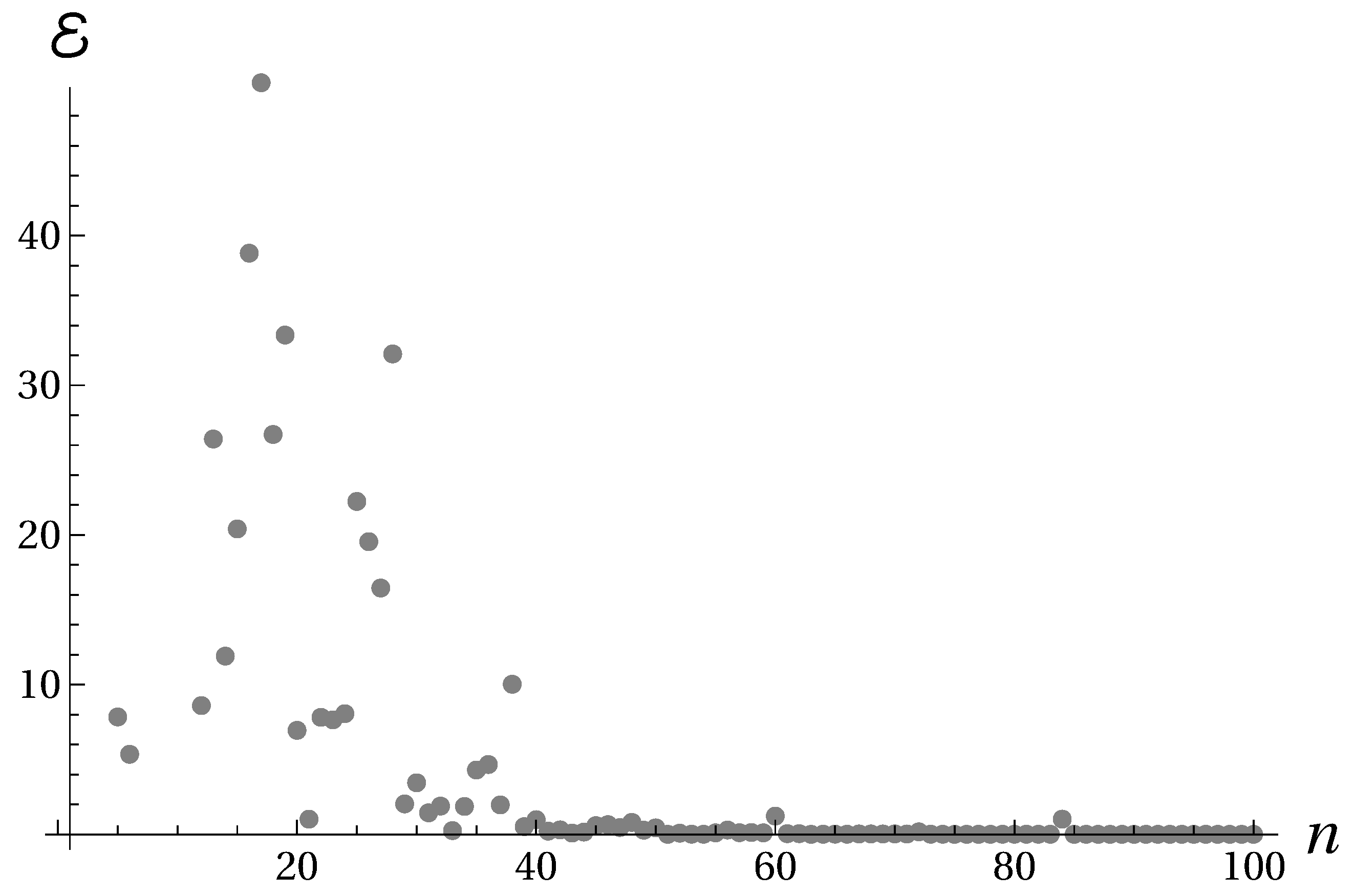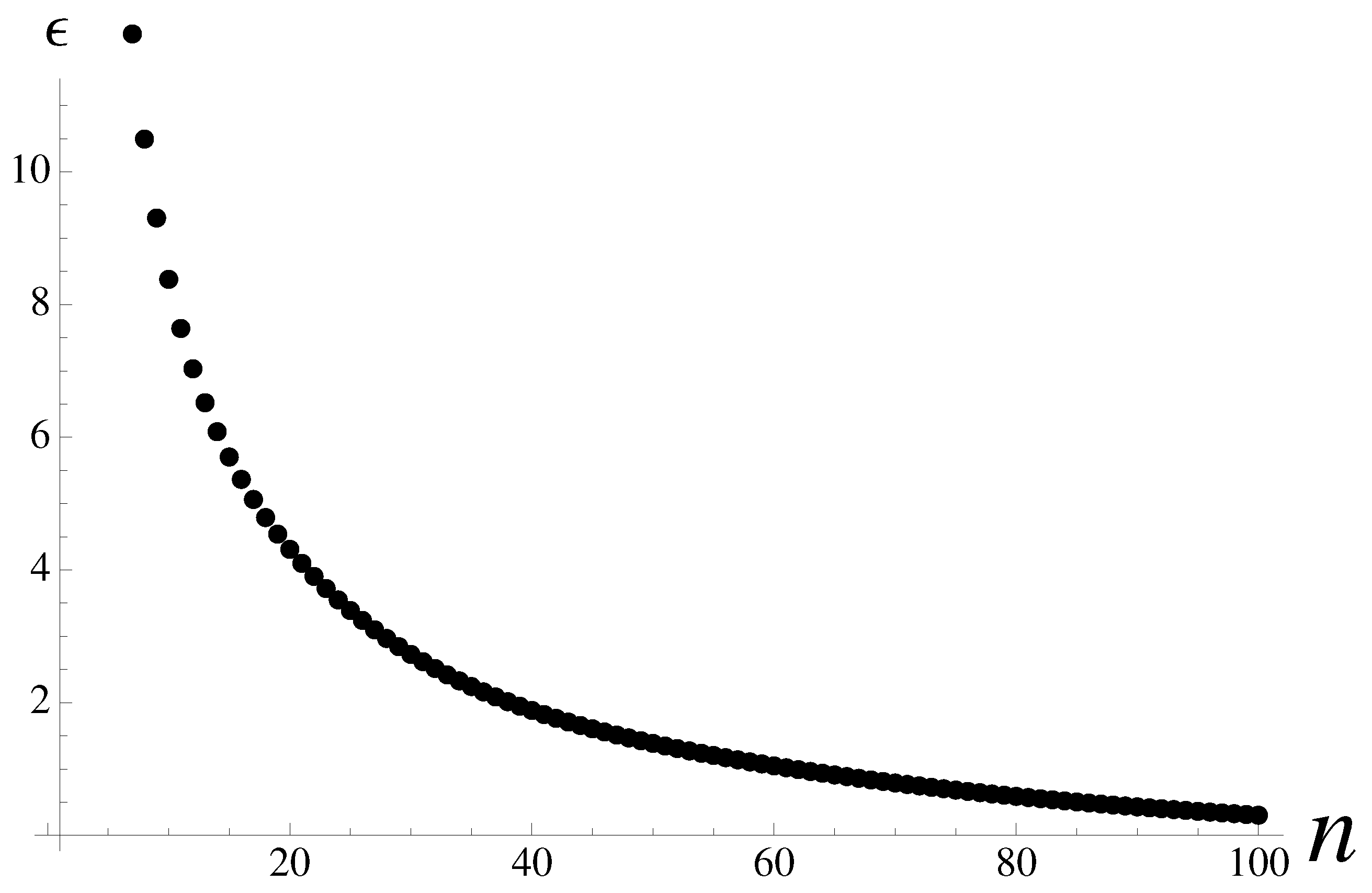1. Introduction
We address an old and important problem of extrapolating asymptotic expansions in powers of a small variable to large values of the variable [
1]. It is very often confronted in various disciplines of natural science and applied mathematics. Of course, one would like to have an exact solution to a realistic problem. But such problems are too complicated, and do not allow to obtain exact solutions. Most often one would try to develop some kind of a perturbation theory [
2,
3]. Then, the sought quantities are given in the forms of most often divergent expansions. More precisely, expressed as truncated series in powers of a small positive parameter, say
x, as
. Out task is to recast such divergent series, into convergent expressions by means of analytical constructs called approximants.
The main difficulty arises because the problem of interest pertains not to a small variable, but to a large values of this variable. In the most extreme scenario it is the infinite limit, as , that should be found. In practice, only several expansion terms can be derived. And the resulting asymptotic series are divergent. The hard problem consists in reconstructing from the several terms of an asymptotic expansion as completely different limit as .
The variable can represent some practically important situations. It can be a coupling constant in field theory, or concentration of particles in composites. Based on the same asymptotic material, such as series coefficients, thresholds, critical indices, correction to scaling indices one can construct not only Padé but also post-Padé approximations. The list of such approximants is not complete or finished by any means. It includes tentatively Padé, -Padé, -Padé, factor, root, corrected Padé, additive, -additive approximants etc.
In a more rigorous terminology, we are interested in the behavior of a real function
of a real variable
. Let this function be the solution to some complicated problem. And the problem would not allow for an explicit knowledge of the function. In order to solve such problem we sometimes manage to come up with some perturbation theory. The theory yields asymptotic expansions about
,
One often extrapolates small-variable expansions by means of Padé approximants denoted as
[
4]. Straightforward application of these approximants yields asymptotic behavior which depends on the concrete values of
M and
N. The Padé approximant can tend to either infinity, to zero, or to a constant. In that sense, the limit
is not well-defined. One would like to reduce the uncertainty. To this end we can agree to prefer the diagonal Padé approximants over other alike sequences. The method of corrected approximants allows to accomplish such task [
5,
6]. It is also ill-advised to forgo the well developed techniques of Padé approximants. The corrected Padé approximants are applicable the problems indeterminate from the view point of a standard Padé approximants [
6,
7]. The technique will be applied extensively in the
Section 3.
One can think that the idea of corrected approximants [
6,
7,
8], is going to have the advantage over all other techniques, because it permits to combine the strength of a few methods together. Then, in the space of approximations, one can proceed with piece-wise construction of the approximation sequences. In [
5,
6], we observe that technique can solve some hard problems by combined application of the two approximation methods, even when each of them separately failed.
In a nutshell, the Padé approximant to an analytical function at a regular point is the ratio of two polynomials of the degree M and of the degree N. The approximant with plays often a central role in various studies. It is called a diagonal Padé approximant of order N.
The beauty of Padé approximants is striking. The coefficients of the approximants can be derived explicitly from the coefficients of the given power series from the solution of a linear system of equations. To this end we impose the requirement of asymptotic equivalence to the given series (
1), representing the sought function
. The poles of Padé approximants determine singular points of the sought functions [
4]. But the functions in the vicinity of their critical points, in general, are non-rational. Therefore the direct use of Padé approximants for finding critical behavior is impossible.
Often, in addition to the expansion about
, an additional information is available. It is contained in the expansion about
,
A two-point Padé approximant to
is a rational function constructed in such a manner that both asymptotic forms, (
1) and (
2) are satisfied. More can be learned from the comprehensive books [
4,
9].
However the accuracy of the two-point Padé approximants is not high. Moreover it confronts several real difficulties [
7,
8]. The standard situation in many problems is when for small
x one has an expansion in integer powers,
, and for the large-variable expansion exhibits the behaviour with a non-integer power
. To overcome the problem of incompatibility of the Padè techniques, Baker and Gammel [
10], used the fractional powers of Padé approximants. The simplest case of the Baker–Gammel method is the polynomial approximant in a fractional power. See also [
1] for similar modification to the Padé approximants. Still, even the Baker–Gammel approximants represent correctly only the leading term of the large-variable behaviour.
One should also remember about the optimized perturbation theory [
11,
12]. It is based on the technique of optimization with special techniques for introducing control functions. Within the framework of the variational perturbation theory [
13], the control functions are introduced differently. One has to consider special variable transformation with optimization parameter. Subsequently, variational optimization conditions are imposed.
The self-similar approximation theory developed by V. I. Yukalov and L. P. Yukalova in 1990–1996, can be used without introducing control functions, which makes calculations essentially simpler (see e.g., [
7] for extensive references). See also the review [
14], where notion of self-similarity is comprehensively discussed. Wildly successful and popular method of renormalization group in quantum filed theory and phase transitions [
2,
15], is based on improvements to a perturbative expansions by uncovering or imposing self-similarity. Ironically, celebrated
-expansion for the critical indices [
15], appeared to be asymptotic and require resummation by themselves, see e.g., [
16]. The so-called super-exponential approximants give rather good resummation results for all spatial dimensions and number of components of the order parameter [
16].
Various approximants employed in the present paper were obtained by same principle, by employing the asymptotic expansions and self-similarity imposed in the space of approximations [
17].
Even when just a few coefficients in the expansion are known the above mentioned methods provide reasonable accuracy. For instance, equations of state can be derived in two and three dimensions, complying well with the experimental data [
8]. Asymptotic approaches and interpolation with Padé and modified Padé approximants are successfully and extensively employed in mechanics and aerodynamics [
18,
19].
In our brief introduction, we tried no to repeat, to the best of our ability, some well-known facts and formulas, unless it was absolutely necessary. They are extremely well presented in treatises by Baker, Bender, Andrianov and Awrejcewicz with colleagues.
Nevertheless, some current developments in the field still need elaboration. Hence, the current paper. The paper should not be taken for a pure mathematical research (or review). In fact, it is a collection of practical recommendations, intended to advice how to use various results obtained in the mathematical theory of approximations in various practical contexts. We believe such recommendations are important for people working in applied science. Wherever it is possible we separate rigorous mathematical facts and mathematical definitions from a more informal discussion suggested for a reader interested in practical usage.
4. Additive Self-Similar Approximants and DLog Additive Recursive Approximants
Consider again the function on a given interval. Suppose, as usual, that for the sought function we find its asymptotic expansion near one of the domain boundaries. Say, for asymptotically small
,
And the truncated in
k-th order series
are given.
The main difference with previous cases comes from the special form of the asymptotic behavior at large x. It is available in rather general form
most often given in more specific form as the finite series
It is assumed that the real powers appear in the descending order as explained in [
38]. It is not possible to apply iterated roots or factors to interpolation in such case. Many examples of interpolation with roots are given in [
32,
38]. Although it is possible to apply root approximants in their general form to such case, their accuracy may be not be always sufficient for practical purposes. Specifically for such cases, the technique of additive approximants was advanced in [
39]. It was successful in solving extrapolation and interpolation problems with fast growing coefficients
. But the realistic problems of the elasticity theory of composite materials [
8,
40], required even further improvements of their performance. In [
40] only the particular case of the
additive approximants was considered. The general case was investigated in [
8]). There we advanced even further elaborated version of the additive approximants, the so-called
additive approximants [
8,
40]. In the Section we recapitulate some definitions and present several examples.
Additive Approximants
In applications we are often have to attack the very difficult case, when the coefficients
unknown [
8,
40]. In such case they might be estimated from the known coefficients
,
. The idea behind the additive approximants is pretty simple: let us dwell more on the shape of the strong-coupling expansion. And let us take it as a basic form of the approximant, but let us get each shifted by same amount, to make possible to re-expand it at small couplings to be able to use the known coefficients for weak couplings.
For completeness, we remind the definition of additive approximants [
39]. First, the variable
x is subjected to the affine transformation
consisting of a scaling and shift. This transforms the terms of the original series series as
where
. Then the affine transformation of its terms, yields the additive approximants
The powers of the first
k terms of this series correspond to the powers of series in the strong-coupling limit
. All coefficients
can be found from asymptotic correspondence to the weak-coupling expansion.
Consider a complementary approach, based on the expansions written in the vicinity of a known critical point. We can advance the following additive ansatz for the effective quantity (such as effective shear modulus [
8,
40], valid in the vicinity of
,
and
. The critical index
can be positive or negative, and the correction index
is always positive.
The expression (
45) extends the ansatz considered for the problem of effective elastic moduli, with
,
[
8,
40]. Such approximants are positioned to solve the case, when in addition to the leading singularity there are added confluent singularities. The confluent singularities disappear in the critical point. Yet, their influence can not be overlooked further away from the critical point.
4.1. Additive Recursive Approximants. Finite Critical Point
The additive approximants tend to become more accurate, when the following transformation is introduced. It is inspired by the known
technique for critical index calculation [
4]. Specifically, it incorporates the known values of the threshold and index and, on top of that, takes care of the confluent additive corrections [
8,
40].
The critical index
enters, as
, the standard representation in terms of the following derivative
Let us define a corrected ansatz, which is specifically constructed to take into account confluent additive singularities. It can be considered as an extension of the approximation of (
46) to all
x,
for all
. The RHS of (
47) is nothing else but the familiar additive approximant. In such formulation we can derive formulas satisfying both types of expansions in the two relevant asymptotic cases. Here the values of
are to be computed from the available asymptotic information.
The problem is greatly simplified because computation of
can be reduced to integration
which can be performed explicitly in arbitrary order. Thus it is possible to find closed-form expressions.
For all
one can find the formula
which expresses
additive approximants
for the quantity
. For
we simply have
The factored contribution
persists through all higher-order approximations. Its role is to guarantee the correct form of the leading, scaling term at infinity. The confluent singularities are taken into account with the high-order contributions coming from the exponential terms. One can find the following approximations in a few starting orders,
We see that
plays the role of the initial guess, which could be, in principle, replaced by some other from with same asymptotic behavior at infinity. Nevertheless, it
is quite general. It is sometimes addressed as Sommerfeld approximant, suggested in [
41]. It was suggested in the course of solving the Thomas-Fermi equation (see., e.g., [
29]). Sommerfeld approximant is also the simplest root approximant (
28) in the lowest non-trivial order. It follows naturally from the self-similarity combined with algebraic transformation of the original series, called together algebraic self-similar renormalization [
17].
Conductivity of Regular Composite. Hexagonal Array
Let us also consider the regular hexagonal array of ideally conducting cylinders of concentration
f. As usual the cylinders are embedded into the matrix of a conducting material. In the case of a hexagonal array of inclusions, there are rather long expansions in concentration, presented an analyzed systematically [
7]. Below, this expansion is presented in the truncated numerical form
with more terms available, up to
[
7]. The threshold
in the case of hexagonal array is known, and
. In the vicinity of threshold we also found [
7], the following short expression,
After some computations we found a very accurate formula (
53), with maximal error of
, compared with numerical data of [
42],
where
or explicitly
The correction term is nothing else but the Padé approximant
, given as follows
The approximation (
53) is better than our previous best result with the error of
[
7]. We are also able to suggest a more compact formula in terms of only the
-additive approximant
, with maximal error of only
. After utilizing asymptotic correspondence with two available asymptotic forms, the approximant is expressed explicitly and compactly,
The analogous problem for the square array of inclusions was also considered in [
8]. The most accurate formula was obtained, with negligible error of
[
8]. It seems that more terms are needed for the case of hexagonal array to achieve the same accuracy as in the case of square array. Alternatively, one may consider some additional technique to stabilize the coefficients
, in the spirit of [
43]. Such technique allowed to consider critical phenomena in the case of honeycomb lattice of inclusions with randomly distributed vacancies.
4.2. Additive Recursive Approximants. Critical Behavior at Infinity
Consider separately the case when critical behavior occurs at infinity so that
and
. The critical index
can be estimated from the following representation in terms of the the derivative
as
. Thus we define the critical index
as the residue in the corresponding single pole
. The pole is located at negative
x. In this case the relevant singularity leads to the critical behavior at infinity. Let us define the ansatz, which is specifically constructed to take into account confluent additive singularities at infinity. It can be considered as an extension of the approximation (
59) to all
x,
. Here the values of
and
are to be calculated from the available asymptotic information. The RHS of (
60) is nothing else but the familiar additive approximant The integration can be performed and the formula can be found which approximates
in arbitrary order, since the integration can be performed. Let us define
Again,
has the form of Sommerfeld approximant [
41]. For all
one can find the recursion-type formula,
Yet, for each
n, the unknown coefficients in (
61) should be calculated anew. The same holds for the formula (
49). For example
In the following examples the critical point is located at infinity.
4.2.1. Anharmonic Partition Integral. Interpolation
Consider again the integral (
38), but this time within the context of the interpolation problem. Namely, in the low orders relevant for our purpose,
is given explicitly by (
39). At strong coupling, we preserve also an additional term to the leading scaling, so that
where
In this particular case
and
. From the general recursion for the
-additive approximants we can construct the following two approximants
The parameters, including
can be found from the conditions of asymptotic correspondence with the asymptotic expressions. The explicit expressions are given below,
The integral (
38) can be calculate numerically, allowing to evaluate the error incurred by the approximations. We found that the maximal error of
is
, and of
is only
.
For comparison we also calculated corresponding additive approximants , . Their respective maximal errors are , and . The Padé approximant was constructed as well, in terms of specially chosen variable. Its maximal error is considerably worse, amounting to .
4.2.2. Quartic Anharmonic Oscillator. Interpolation
Another example, is the quartic anharmonic oscillator described by the Hamiltonian (
32). For convenience, we bring up again the few starting terms in the expansion of the ground-state energy of the Hamiltonian (
32), namely
The value of these coefficients quickly increases, meaning strong divergence of the expansion. In the large anharmonicity limit of
, the truncated series
have fractional powers as in the expansion below:
The first coefficients are known,
For the anharmonic oscillator,
and
. It is clear that in the large-variable limit, recursively defined
additive approximants will reproduce the terms with the powers of series (
66). But, in addition to the terms with the correct powers from (
66) there could possibly appear “parasitic” terms with incorrect powers. And we have to introduce an additional terms, also called counter-terms [
39], to compensate them precisely, in a manner suggested for the additive approximants in [
39]. Thus, in contrast with the case of the anharmonic partition integral, additional counter-terms terms are required.
Indeed, consider the simplest approximant generated from the recursion,
It can be expanded in powers of
at large
g, so that
The term
is incorrect and can not be simply canceled out by manipulating amplitudes. The problem persists to approximants of arbitrary order. More incorrect powers, such as
, appear as well. Such powers should be canceled by including in approximant correcting terms (counter-terms) [
39].
To generate the counter-terms, as well as correct terms, we will use the very same recursion formula, but with
. The only difference would be that we should also set
. Now, we can simply generate approximants and found the unknown parameters by keeping only terms with correct powers. Indeed, consider the following, odd-order approximant
In what follows we can always set
in arbitrary order, to kill the constant addition to the series. Let
be expanded in powers of
at large
g, so that
Let us simply set
and we have the correct powers for the remaining terms. Similarly, with higher-order approximants, one can get rid of the term
, etc. The next odd approximant is designed to kill, in addition, also the term of
.
With the cancellation conditions
it gives the expansion correct to
. Again, applying
we have to kill the terms of
, with the additional conditions
Consider the “minimal” interpolation problem, when only
and
are given. The
-additive approximant can be found as follows
since there is a complex-conjugate pair of solutions for the parameters. The solution is given as half of their sum, and the maximal error is
.
For the additive approximant, in a similar fashion, there is a complex-conjugate pair of solutions for the parameters,
and the maximal error is just
. The error is evaluated in comparison with accurate numerical results of [
44]. The results from additive approximants are significantly better than our own estimates by means of interpolation with roots [
45], with maximal error of
. We also considered the Padé approximant expressed in terms of specially chosen variable,
which brings the maximal error of
. Analyzing the three approximants, we observe that accuracy and compactness of the solutions are complementary. i.e., the most accurate solution has the most extended form.
4.3. Thermal Entropy in N = 4 Super Yang-Mills Theory
Method of approximants is also useful for interpolating thermodynamic entropy
S between dual weak and strong coupling regimes of the ’t Hooft coupling,
. The thermodynamic entropy of N = 4 supersymmetric Yang-Mills theory (SYM) is quantified by the two expansions [
37],
Consider the interpolation problem, when all the terms and conditions from the expansions are employed. It is not possible to solve this problem by direct application of the root approximants (
28), since it corresponds to the “constant at infinity” problem [
1]. It is possible, in principle, to employ the factor approximants (
3), but the problems appears unwieldy for the technical standpoint. Therefore, we have to apply
additive technique which could treat the problem.
First, let us use the variable
, as in [
37]. Then we can apply the recursion, with
,
.
The following approximant
is able to perform the interpolation. It requires though a counter-terms with the amplitudes
so that explicitly, in term of the coupling constant
we obtain rather compact expression
We bring up also the Padé approximant from [
37],
In
Figure 8 the results from (
76) are compared with the (
77). They are in a good qualitative agreement, smoothly interpolating between the two regimes.
One can think that the problem is difficult, because of a wide crossover region between the two asymptotic regimes.
4.3.1. Schwinger Model. Interpolation
The Schwinger model [
46,
47] represents the Euclidean quantum electrodynamics interacting with a Dirac fermion field. It is defined on lattice in
dimensions. It reflects on many properties, the confinement, chiral symmetry breaking, and charge shielding, with quantum chromodynamics. Most interesting, the structure of expansions for Schwinger model appears to remind closely the case of quartic anharmonic oscillator. Therefore, the same technique of construction approximants with counter-terms can be used.
Ground state. We test the technique of
additive approximants first on the case previously explored in [
38], and calculate the ground state of the model, given as a function of the dimensionless variable
. Here
m stands for electron mass and
g is the coupling parameter. It also has the dimension of mass. The energy is
, corresponding to a vector boson of mass
.
The expansion at small-
x the expansion for the ground-state energy [
48,
49,
50,
51] is known as follows,
In the complementary, large-
x limit [
51,
52,
53,
54], there is another truncated expansion
The self-similar root approximant
as defined as in (
28), was applied to the interpolation between the two expansions [
38]. Its detail expression can be also found in [
38]. The accuracy of this approximant
was compared in [
38] to various results of calculations by other researchers. In particular, with the density matrix renormalization group,
[
55], and fast moving frame estimates,
[
56]. The ground state energy has also been calculated by using variational perturbation theory [
57]. However the results were found to be rather cumbersome, and without advantage over other techniques.
With help of counter-terms, we proceed just like in the previous example of the quartic anharmonic oscillator, and set
and
. Then, with
the
-additive approximant reads in general form as follows,
and, after the parameters are computed, we obtain
Let us construct also “just” an additive approximant, which includes all terms from the two expansions for the grouns state energy. The additive approximant corresponds to the pair of complex-conjugated (C.C.) solutions, and the full solution is
where
The accuracy of the approximant
can be compared to various results. We present such comparison in
Table 1, the energy
, found by means of the
-additive approximant (
81). All results are close to each other, being practically the same in the range of computational errors. The Padé approximant
was also constructed in [
38], and it worked with the same accuracy as other techniques. Concrete results for the ground state energy obtained with such approximant, can be found in [
38].
Excited state. Consider now the first excited state of the model, corresponding to a scalar boson. The small-
x expansion for the energy of the excited “scalar” state, can be extracted from [
48,
49,
50,
51] is given as follows,
In the large-
x limit [
51,
52,
53,
54], there is a another, complementary expansion
The problem appears to be more more difficult than ground state problem, likely, because of a non-monotonous crossover region for small x. The root approximant even brings apparently wrong, complex results in this case. Although it works well for the ground state, even solving the most difficult extrapolation problem [
30,
38], allowing to calculate the critical index at infinity with good accuracy.
We can also try to apply the Padé technique. It was already found to work well for the ground state [
38]. Thus, the following Padé approximant
, was constructed. We found that it to be as good as other much more sophisticated techniques. Namely,
Let us consider the
additive technique. With counter-term
the simplest
-additive approximant reads
and, after some calculations, we obtain
Let us construct also “just” an additive approximant, which includes all terms from the two expansions from the scalar state energy. The additive approximant corresponds to the pair of complex-conjugated (C.C.) solutions, and the full solution is
where
The quality of the approximant
can be compared to data obtained in other calculations. For instance with finite lattice estimates,
, obtained in [
51], and fast moving frame estimates,
obtained in [
56]. The energy has also been calculated by using variational perturbation theory [
57]. But the latter lead to some rather complicated formulas, and no advantage over other techniques. In
Table 2, we compare the different data with our result
. Also, we present the energy
found by means of the
-additive approximant (
88). The ground state energy calculated from the Padé approximant (
86), is brought up as well. All results appear to be fairly close to each other.
The
-additive approximants appear to be the most consistent among other self-similar approximations. They are able to adapt well to both cases of ground and excited states. They appear to be as good as the other very heavy numerical techniques, but have the advantage of being more transparent. Modified Padé approximants are also able to solve the interpolation problem for the ground and excited states energies. The technique based on root approximants allows though, to attack successfully the most hard problem of the critical index at infinity, based on information encoded in the very short series for small
x [
30,
38].
4.3.2. Correlation Energy of One-Dimensional Electron Gas. Interpolation
Below we present an accurate expression for the one-dimensional electron gas correlation energy. The energy is conveniently given in a reduced nondimensional form
, Here
stands for Seitz radius. Let recapitulate the known expansions for the to available asymptotic cases [
58].
At small
(high-densities) the following expansion for for the correlation energy is known [
58],
where
In the opposite situation, for the large
(low-densities) [
58], the following expansion is available,
with
In our notations, the value of indices
,
. There are no need for counter-terms, meaning that the general recursion can be applied without complications in the original variables. The
-additive approximant, with the two asymptotic cases included, is supposed to work for arbitrary
. It reads as follows
The series available to us are very short. In order to be able to go to the higher-order approximant, we can fix some unknown parameter to some plausible value. The
-additive approximant, with the same asymptotic expansions, but with the fixed parameter
, could be constructed as well,
Comparing the results of the two
-additive approximants with the data from diffusion Monte Carlo calculations [
58] in the interval
, we find that the maximal error of
is just
, and of
is only
. The Padé approximants are not giving consistent results, while given such short series. They generate the errors varying between
and
. For instance,
has reasonable error of
. But another approximant,
, brings the maximal error of
.
Previously, in [
32], the problem was attacked with root approximants, but the maximal error of
was found. There is a very significant improvement achieved by applying the
-additive approximants. It is highly advantageous that the approximants allow to avoid fitting, bearing in mind those cases where no exact or even approximate numerical data are available. Besides, only in such setting the value of available expansions and quality of various approximants can be evaluated.
5. Concluding Remarks
It is likely a pipe dream to find the same approximant to be the best for each and every realistic problem. Rather we believe into “strength in numbers”, when different approximants are viewed as a group dedicated to the problem solution. Based on the same asymptotic material, such as series coefficients, thresholds, critical indices, correction to scaling indices one can construct not only Padé but also post-Padé approximations. With various approximants (Padé, -Padé, -Padé, factor, root, corrected Padé, additive, -additive etc.) available it is much more probable that for each problem one can find an optimal different one, or even a combination of the few. New approximants are always welcome, even if they allow to solve only a single problem.
Subjectively, we hope that the idea of corrected approximants [
6,
7,
8,
29], is going to have the last word. It allows to combine the strength of a few methods together and proceed, in the space of approximations, with piece-wise construction of the approximation sequences. The corrected approximants also possess strength in numbers.
The approximants are relatively easy to compute based on the known series. And the problem is now centered around finding the best approximation scheme for each concrete problem. It is not less important to have in mind a concrete validation and testing schematics, akin to those developed in machine learning. For instance, one can construct several initial guesses based not on all
, threshold, indices, but only on a part of them, leaving the rest for validation. The best guess could be chosen as the best descriptor to the validation set. After validation all parameters can be incorporated into chosen best approximant, and tested. In the field of effective properties one can use a few numerical points for testing [
7,
8]. One can also try to combine several approximants into a single “super-approximant”, by using regression on approximants [
7], which would involve asymptotic information as well data points. Yet different method of combining such information was developed in [
59].
We remind about another possible application of the approximants. It is notoriously difficult to get hold on the coefficients , especially in high orders. One can try plainly (naively?) to generate additional coefficients from the approximants, as first suggested by Feynman. Sometimes, even the order of magnitude or the sign can be of value.

